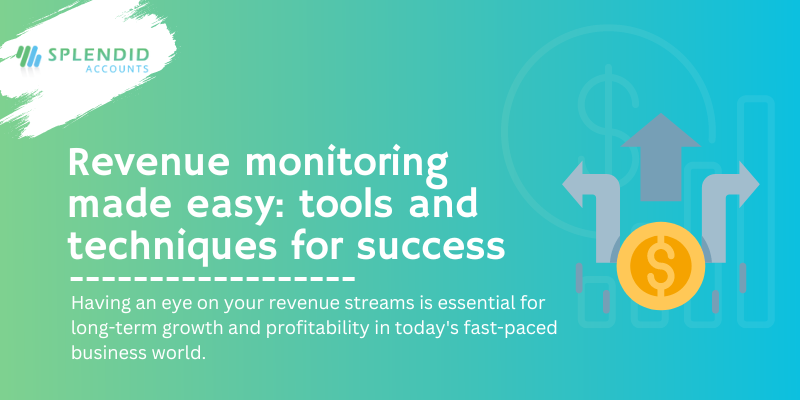
An introduction:
Having an eye on your revenue streams is essential for long-term growth and profitability in today’s fast-paced business world. Income tracking, income analysis, and revenue monitoring are not just catchphrases but vital procedures for any successful organization. Efficient revenue management can be challenging, particularly as a business grows. Fortunately, you can streamline the procedure and gain important insights into your financial performance with the appropriate tools and methods. In this post, we’ll go into revenue monitoring and over important tools and strategies to help you succeed by streamlining your actions.
Understanding the Fundamentals
Let’s define revenue monitoring first before getting into certain tools and methods. The continuous routine of tracking and evaluating the money your company makes is called revenue monitoring. It entails thoroughly monitoring sales, costs, and other financial dealings to grasp your revenue sources. You may maximize your financial success by discovering trends, spotting problems, and making well-informed choices by closely monitoring your revenue.
Making Full Use of Accounting Software
Accounting software is a fundamental instrument for efficient revenue tracking. These online systems contain several features intended to make financial management easier and give you useful knowledge about your sources of income. Investing in a strong accounting system can help an organization.
Accounting software that is widely used, such as Splendid Accounts, QuickBooks, Xero, and FreshBooks, provides features including financial reporting, expense management, income monitoring, and invoicing. With these tools, you can keep track of sales transactions, organize your revenue and expenses, and produce thorough reports that will help you evaluate your financial state. Likewise, many accounting packages link with other company technologies, such as e-commerce platforms and CRM systems, allowing for smoother data flow and enhanced efficiency.
Using accounting software, you can gain real-time visibility into your income streams, automate tedious activities, and minimize manual errors. You will be better equipped to make informed data judgments and promptly adjust to shifting market conditions, leading to higher financial success.
Putting Income Tracking Systems in Place
Using specialized income-tracking solutions in addition to accounting software can improve your revenue monitoring efforts. Income monitoring systems are specialized gadgets that precisely collect and evaluate revenue data. These systems frequently provide cutting-edge capabilities designed for particular business models or industries, giving clients greater clarity about your revenue streams.
For instance, retail establishments often use Point-of-sale (POS) systems to handle transactions involving sales, track inventory levels, measure performance in sales, and generate sales reports. Subscription management tools that monitor recurring revenue, churn rates, and loyalty indicators may also be used by subscription-based organizations.
Investing in income-tracking technologies that fit your business model will help you understand your revenue streams and progressively pinpoint areas that need work. These insights can result in significant growth and profitability, whether used to target high-value customer categories, optimize pricing tactics, or save operating expenses.
Conducting Income Analysis
Complete income analysis, in addition to collecting revenue data, is crucial to optimizing financial performance. Analyzing your income entails examining a range of metrics and KPIs, or key performance indicators, to assess how well your revenue streams perform. By looking for patterns, signs, and correlations in your income data, you can gain important insights and spot areas for optimization.
When conducting an income analysis, some essential variables to take into account are:
Revenue Growth Rate:
Determine how quickly your revenue rises over the long term. A steady or increasing growth rate indicates positive business performance.
Income Mix:
Examine how your income streams comprise different product/service fields, clientele groups, and sales channels. Determine which sources ultimately bring in the most money for your business, then focus your efforts there.
Determine the average revenue earned per client or customer (ARPC):
This indicator is useful for estimating a client’s worth and pinpointing areas where the customer’s lifetime value (CLV) can be raised.
Profit Margins:
Determine the profitability of your revenue sources by comparing income to related spending. Then, identify high-margin services and products and areas of opportunity for cost reduction.
Calculate the cost of acquiring a new customer using the Customer Acquisition Cost (CAC).
Compare CAC to client life span value to ensure successful and sustainable growth.
You may comprehend your revenue drivers, spot possible bottlenecks or inefficiencies, and develop performance-enhancing initiatives by conducting thorough income analysis.
Conclusion:
Efficient revenue tracking is critical to every organization’s long-term success. Using the right instruments and methodologies, such as accounting software, income monitors, and income analysis, you may optimize your financial control procedures and obtain significant perspectives on your sources of money. Whether you run an enormous corporation or a tiny startup, putting money into effective revenue monitoring procedures can help you develop, make wise decisions, and turn a profit that will last. Accept the power of data-driven financial administration to succeed in the cutthroat corporate world of today.
